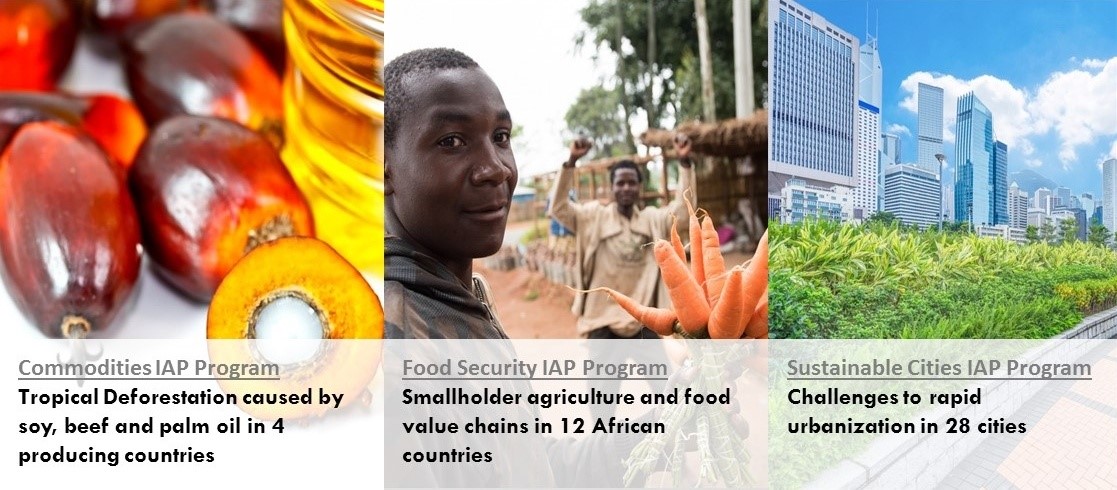Formative review of the integrated approach pilot (IAP) programs - Part 1
As part of the GEF-6 replenishment phase, the Global Environment Facility (GEF) introduced three integrated approach pilot (IAP) programs. These programs aim to address global environmental issues more holistically and help recipient countries generate global environmental benefits that correspond to more than one Convention or GEF focal area. The specific drivers of environmental degradation tackled by each program are the following:
- Commodities IAP Program: agricultural expansion in emerging markets leading to deforestation from commodities production
- Food Security IAP Program: food production in natural resource poor farming systems
- Sustainable Cities IAP Program: processes of unsustainable urbanization in rapidly growing cities of Asia, Africa and Latin America.

The Independent Evaluation Office (IEO) of the GEF was tasked to review these programs. Given that many of the child projects under these programs have yet to commence implementation at the time of evaluation, the review adopted a formative approach and focused on relevance, process and design aspects at start-up, their uptake by key stakeholders in the target countries and the process through which these three IAP programs have been and are being launched. The Council document of the Formative Review of the Integrated Approach Pilot (IAP) Programs can be downloaded here.
Findings are organized under four main themes: relevance, design, process and cross-cutting issues. In this first part of the blog post, I'll discuss the findings on relevance and design. Findings on process, cross-cutting issues and a look ahead will be discussed in the next blog post.
FINDINGS - Relevance
- In-country stakeholders broadly agree on the potential for the IAP programs to address multiple conventions through an integrated programming approach; this view was not shared by all Convention secretariats. Ninety-three percent of respondents agreed that the IAP programs help to address the Conventions across multiple scales. Interviewees at UNFCCC and CBD secretariats were somehow more critical. In contrast, those interviewed at the UNCCD Secretariat fully supported the GEF integrated approach to multiple focal areas.
- Positive examples of alignment with country priorities through adequate entry points are observed, although this strategy risks sidelining some focal areas. The Commodities IAP child projects align with specific government priorities, and the relevant focus areas are biodiversity, climate change as well as support for sustainable forest management. The Food Security IAP shows synergies across biodiversity, climate change, and land degradation, with financial allocations clearly favoring the latter as an entry point. Interviews indicated that the biodiversity and climate change were included as more of an afterthought in project design. The major drivers of the Sustainable Cities IAP connect local urban sustainability priorities to climate change mitigation, biodiversity and chemicals.
FINDINGS - Design
- The IAP programs and their component child projects are broadly coherent in terms of their structure and objectives in their respective theory of change, with some exceptions. The IAP program and project objectives and M&E systems are aligned with each other. However, alignment between project/program results frameworks and tracking tools in terms of outcomes and indicators does not show an even picture across the three IAP programs. Only two projects in the Cities IAP show alignment between project/program result frameworks and tracking tools. Three out of five child project in the Commodities IAP and five out of 12 in the Food Security IAP align.
- IAPs demonstrate interesting innovative features as compared with previous programs by including emphasis on knowledge exchange through dedicated platforms for collaborative learning, though considerable efforts will need to be made to realize their potential. The main innovation for the three IAP programs is the development of ‘hub projects' for each IAP program, that function as capacity building, coordination and knowledge support platforms or networks towards the other child projects. This is a clear improvement as compared with past programs. The success of the IAPs largely depends on the effective functioning of the hub projects.
- Broader adoption has been emphasized in the design of the IAP programs. All child projects have a plan for sustaining project interventions beyond the project's timeframe. Almost all child project documentation provides evidence of specific measures for planned broader adoption of outcomes by stakeholders such as replication at a comparable administrative or ecological scale, scaling up interventions into larger geographical areas, and measures to help catalyze market transformation.
- IAPs show well-designed M&E strategies, with some exceptions. M&E is historically a weak area in GEF programs in terms of its capacity to demonstrate program additionality, but it has been carefully considered in the design of the three IAPs. All child projects have an M&E strategy and show coherence between program and child project M&E frameworks. A multifocal tracking tool was developed by the Food Security IAP, which is yet to be operationalized.
- There are inconsistencies in the role, expression and measurement of global environmental benefit (GEB) targets, which will adversely affect program-level M&E. All three IAPs provide targets towards GEBs, but the data is scattered throughout program and project documents, and it is not clear whether these are meant as aspirational goals or as hard targets. Program documentation lacks targets altogether (Commodities IAP), underestimates (Cities IAP) or overestimates (Food Security IAP) GEB targets, compared to targets reported in child projects' documentation. Variations exist in child projects' calculations of direct and indirect CO2e mitigated; different periods of influence and poorly substantiated indirect top-down causality factors are being used.
Conclusions
The above findings led to the following two conclusions that relate to relevance and design:
- Integrated programming to tackle the main drivers of environmental degradation through the IAPs enables addressing the objectives of multiple conventions, while allowing participating countries to address national environmental priorities.
- The IAPs have pursued an innovative and flexible design to address the drivers of environmental degradation, but show a wide variety of indicators and tracking tools, hindering aggregation within each IAP as well as for the three IAPs all together.
In the second part of the blog post, I'll discuss the findings on process, cross-cutting issues and will be looking ahead.
Some Resources:
- IEO, Draft Final Report of the Sixth Comprehensive Evaluation of the GEF (OPS6) , October 2017. Council Document GEF/ME/C.53/Inf.01.
- IEO, Evaluation of the Programmatic Approaches in the GEF , May 2017. Council Document GEF/ME/C.52/Inf.01/Rev.01.
- IEO, Formative review of the integrated approach pilot (IAP) programs , November 2017. Council Document GEF/ME/C.53/Inf.04.
- IEO, Semi-Annual Evaluation Report of the Independent Evaluation Office , November 2017. Council Document GEF/ME/C.53/01.
- GEF, PFD document of Cities-IAP: Sustainable Cities Integrated Approach Pilot (IAP-PROGRAM) , GEF ID 9077, April 2015.
- GEF, PFD document of Food Security-IAP: Sustainability and Resilience for Food Security in Sub-Saharan Africa Integrated Approach Pilot (IAP-PROGRAM) , GEF ID 9070, May 2015.
- GEF, PFD document of Commodities-IAP: Taking Deforestation out of Commodity Supply Chains Integrated Approach Pilot (IAP-PROGRAM) , GEF ID 9072, April 2015.



